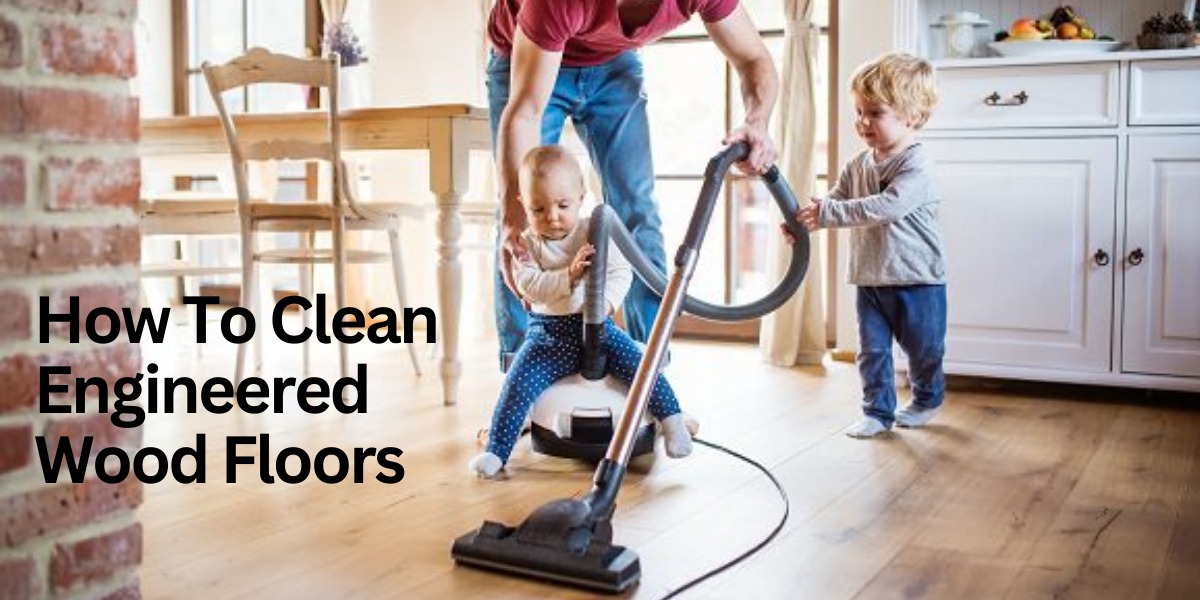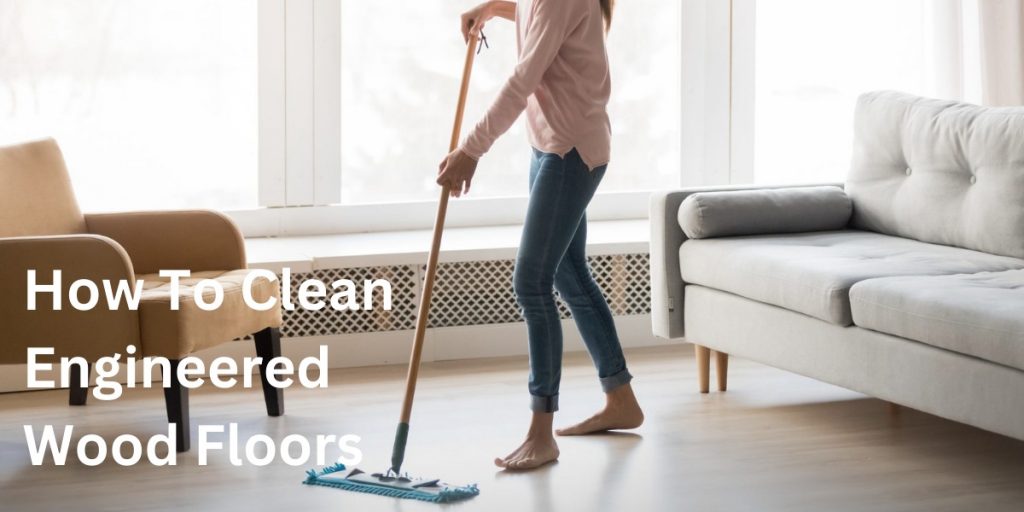How To Clean Engineered Wood Floors?

Are you tired of trying multiple cleaning methods that haven’t worked for your engineered wood floors? You’re not alone! Cleaning hardwood floors can be tricky, especially when it comes to engineered wood.
Fear not—there are some simple and effective ways to keep your beautiful floors looking like new with just a little TLC. In this blog post, we’ll guide you through the dos and don’ts of cleaning engineered wood flooring, so you can enjoy stunning results without any hassle or damage. Let’s get started!
Cleaning Process
When it comes to cleaning your engineered wood floors, there are a few things you should keep in mind. First of all, make sure to use a floor cleaner specifically designed for engineered wood. Secondly, be sure to wait until the floor has completely dried before moving or stepping on it. Finally, always wear gloves and eye protection when cleaning your floors.

Types of Cleaners for Wood Floors
There are many types of cleaners for wood floors, but the most common are:
- Water: This is the simplest type of cleaner and does the job well. Just wet a cloth and wipe down the floor.
- Vinegar: Vinegar is another common type of cleaner and works well on most surfaces. Just pour it on a cloth and wipe down the floor.
- OxiClean: This product is specifically made to clean wood floors. It comes in a spray bottle and requires no scrubbing. Just spray it on, let it sit for a few minutes, then wipe it off.
- Ammonia: Ammonia is a more powerful cleaner and is best used on heavily soiled areas or if the floor has been stained. Pour ammonia into a bucket or container, add water, and stir until the mixture forms a thick liquid. Soak up as much of the dirt as you can with the cloth before spraying it with ammonia. Spraying ammonia onto wood will cause severe damage so be sure to use gloves and eye protection when using this product.
Recommended Products for Cleaning Wood Floors
When it comes to cleaning wood floors, there are a few products that can be recommended. Some of the most common floor cleaners include those made specifically for wood floors, such as ammonia and bleach.
It is important to use the right amount of cleaner and avoid scrubbing the floor too hard. Also be sure to clean all the nooks and crannies around furniture and appliances.
Another product that can be used to clean wood floors is a vacuum cleaner with a hose attachment. Be sure to use the right type of attachment – one that is specifically designed for wood floors – in order to avoid leaving behind dirt and dust trails. Additionally, using a wet mop instead of a dry one will help keep the floor clean while eliminating water spots.
How to Clean Engineered Wood Floors
Cleaning engineered wood floors can be a bit of a chore, but it’s definitely possible. Here are some tips on how to clean them:
- Start by dusting the floor with a soft cloth to remove any excess dirt or debris.
- Use a cleaner designed specifically for engineered wood floors, such as furniture polish or simply white vinegar diluted with water. Apply the cleaner to a cloth and work it into the pores of the floor. Be sure to focus on any areas that seem dusty or dirty.
- Let the floor dry completely before walking on it again.
Prepping your Wood Floor for Cleaning
If your wood flooring is stained, dirty or just needs a good cleaning, there are a few things you can do to prepare it. Start by removing any excess dirt, dust and debris with a vacuum cleaner. If the flooring is severely dirty, you may also need to use a mild soap and water mixture to clean it. Be sure to rinse the flooring off thoroughly after cleaning.
If the wood floors have recently been installed, be sure to seal the finish with a coating such as protectant or sealer before cleaning. This will help prevent water and dirt from damaging the wood surface.
If you have hardwood floors, be sure to get them professionally cleaned every six to twelve months by a professional restoration company. This will ensure that your flooring remains in top condition and free of any stains or damages caused by regular wear and tear.
Cleaning Service In Dubai UAE
Are you looking for a reputable and reliable cleaning service in Dubai? Look no further than Tadbeer Center! Our team of experienced Domestic Helpers is equipped with the latest cleaning equipment and techniques to give your home the cleanest it has ever seen. From deep cleaning to dusting and vacuuming, we will have your place looking spick and span in no time. Contact us today to schedule a free consultation!
The Different Types of Cleaning Agents for Engineered Wood Floors
There are different types of cleaning agents that you can use on your engineered wood flooring to get the dirt and dust cleaned up. Some of the most popular include:
- Water: If all you need is water to clean your floor, then sprinkling a little on the floor and scrubbing with a cloth is usually enough.
- Ammonia: A common household cleaner found in most stores, ammonia can be used to clean wood floors by wetting the surface and then spraying it with the solution. Use a scrub brush to work the ammonia into the cracks and crevices of the wood.
- Baking Soda: A natural acid, baking soda can also be used as a all-purpose cleaner on wood floors. Simply mix one teaspoon of baking soda with two cups of warm water and spray or pour over the surface to be cleaned. Work it into the grain with a scrub brush if needed.
- Citrus Fruits: Though they may not be typically thought of as cleaners, citrus fruits such as oranges, lemons, and limes can help take care of dirt and dust build-ups on wood floors. Cut an orange or lemon in half, squeezing some juice onto the floor, and using a cloth or mop to cleanup.
How to Use the Right Cleaning Agent for your Floor
Cleaning engineered wood floors can be a daunting task, but with the right cleaning agent and technique, it can be done easily. There are a few things to keep in mind when cleaning an engineered wood floor:
- Always use a mild, non-abrasive cleaner on your floor. This will help preserve the finish and avoid damage to the floor.
- Use a microfiber cloth to clean hard-to-reach areas.
- Wipe down the entire surface of the floor once you’ve finished cleaning it. This will remove any excess residue and prevent future spotting.
Tips for Preventing future Damage to Your Wood Floor
Wood floors are beautiful, but they can be delicate. Make sure you take the proper precautions to keep them looking and feeling their best.
- Clean regularly: Wood floors need to be cleaned on a regular basis to keep them looking new and clean. Dust and dirt will build up over time, which will cause scratches and other damage.
- Use a vacuum cleaner with a crevice tool: A regular vacuum cleaner doesn’t have a crevice tool, so use one of these for deep-cleaning your wood flooring. This will help remove any dust, hair, or debris that has built up over time.
- Avoid harsh cleaners: Some people think using harsh cleaners on wood floors is necessary in order to get them clean. However, this can actually damage the flooring over time. Stick with mild cleaners if you must use something cleaning-related on your wood flooring.
- Protect against water damage: Always protect your wood flooring from accidental water damage by closing all rooms off when taking a shower or washing dishes. If there is any chance of water coming into contact with the wood flooring, it’s best to avoid it completely! More Post Visit.
- Samsclub can be a one-stop-shop for all your daily needs. With its impressive range of products, excellent customer service, and reasonable prices, it has won the trust of millions of customers. From groceries to electronics, to furniture and appliances, you can find everything under one roof.




